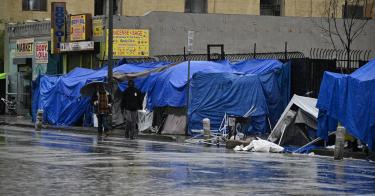Homelessness set two records in 2023. The increase in homelessness between 2022 and 2023 was the largest ever recorded since the government began collecting data in 2007. That brought the number of Americans living in homeless shelters and on the streets to an all-time high.
The problem is neither new nor local. Homelessness has been rising for several years. Last year, it increased in all but nine states, with New York topping the list. New York City Mayor Eric Adams recently announced that the city’s homeless shelters are out of room due to soaring illegal immigration.
Evidence of the accompanying social decay can be found coast to coast: in Portland streets littered with hypodermic needles and other waste, on San Francisco sidewalks covered with human feces and tent encampments, and with increasing numbers of people languishing on the streets of Los Angeles.
Some unique factors contributed to the jump in homelessness in 2023, but policies to address homelessness have been off track for a long time. For two decades, the federal government has taken a “housing first” approach to homelessness, focusing on “permanent supportive housing” with low or no barriers to entry.
This means providing permanent housing without any conditions, such as meeting sobriety requirements, participating in drug treatment, engaging in mental health counseling or participating in job training. The idea is that giving a person housing will solve homelessness.
>>> Open Borders Creating Bidenvilles of Homelessness. Who Saw That Coming?
But housing first has failed on several counts.
While it increases the likelihood that an individual remains housed—at least for the people who receive permanent housing—housing first fails to reduce overall rates of homelessness or to improve other outcomes of well-being. Indeed, some places that have increased their supply of permanent supportive housing have seen homelessness grow.
For example, between 2010 and 2019 California increased its number of permanent supportive housing units by 25,000, but the number of unsheltered homeless people in the state increased by 50%.
How can this be? Some people may stay in permanent supportive housing longer than they would have remained homeless, occupying units that would otherwise be available for others. Others may migrate to an area that offers permanent supportive housing.
Housing first may also incentivize people to remain homeless longer in order to receive free housing. Whatever the reasons, Kevin Corinth of the American Enterprise Institute estimates it takes 10 permanent supportive housing units to reduce homelessness by just one person.
Housing first is also expensive. A housing-first project in Los Angeles has cost the city $690,000 per unit.
Prioritizing housing first also means that programs requiring treatment or behavioral change are penalized, even though “treatment-first” approaches are more successful at improving the well-being of homeless people by reducing drug use and increasing employment stability. By focusing on helping people move forward in their lives, treatment-first programs can ultimately serve more people too, since they are not designed to keep people in government-funded housing permanently.
The Birmingham Model is an example of a successful treatment-first program. It combines housing with treatment, providing people with a private unit while requiring recipients to abstain from substance abuse. Those who fail to remain sober are moved to a spot in a shelter; they can work toward regaining the private unit by staying sober for a week.
The federal government should stop prioritizing the costly and inefficient housing-first approach. Instead, funding for programs addressing homelessness should be tied to improved outcomes, such as reduced substance abuse, better mental health, moving people into self-supported housing, and reducing overall rates of homelessness. Approaches to helping the homeless will vary based on the individual.
Many people living on the street are dealing with severe mental illness. States should work to improve their mental health care systems and to increase the number of hospital beds available for the severely mentally ill. These beds are in very short supply.
Some cities have programs to provide short-term rental assistance to those facing eviction, along with services to help people find a job. This may help prevent homelessness in the first place.
Local leaders could work with nonprofit organizations to see that emergency and short-term shelters are available for those in crisis. At the same time, cities should maintain order on the streets by ensuring that public areas are free from tent encampments and that laws against illegal drug use and theft are enforced.
Helping the homeless should focus on addressing the underlying causes, rather than continuing to fixate on symptoms. Policies to help our brothers and sisters should promote wellness and upward mobility to help people find their way home.
This piece originally appeared in MSN


